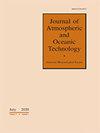基于大涡模拟和反演的海洋混合层模式改进
IF 1.9
4区 地球科学
Q2 ENGINEERING, OCEAN
引用次数: 1
摘要
利用大涡模拟和反演方法对海洋混合层模型进行了改进。对OMLM(Noh模型)和LES结果的比较表明,当风应力较弱或纬度较高时,低估OMLM中的湍流动能(TKE)通量会导致对流过程中混合层深度(MLD)的负偏差。进一步发现夹带层厚度被低估了。为了减少偏差,研究了OMLM中参数化的替代方法的影响,如非局部混合、长度尺度、普朗特数和TKE通量。然后,以LES数据为约束数据,通过迭代格林函数方法,对具有不同参数化选项的不同版本的Noh模型中的经验常数进行同时优化。获得了一个改进的OMLM,它反映了各种新的特征,包括增强的TKE通量,并且发现新模型在所有情况下都能提高性能,即风混合、表面加热和表面冷却情况。还研究了OMLM网格分辨率对最优经验常数的影响。本文章由计算机程序翻译,如有差异,请以英文原文为准。
Improvement of the Ocean Mixed Layer Model via Large Eddy Simulation and Inverse Estimation
The ocean mixed layer model (OMLM) is improved using the large eddy simulation (LES) and the inverse estimation method. A comparison of OMLM (Noh model) and LES results reveals that underestimation of the turbulent kinetic energy (TKE) flux in the OMLM causes a negative bias of the mixed layer depth (MLD) during convection, when the wind stress is weak or the latitude is high. It is further found that the entrainment layer thickness is underestimated. The effects of alternative approaches of parameterizations in the OMLM, such as nonlocal mixing, length scales, Prandtl number, and TKE flux, are examined with an aim to reduce the bias. Simultaneous optimizations of empirical constants in the various versions of Noh model with different parameterization options are then carried out via an iterative Green’s function approach with LES data as constraining data. An improved OMLM is obtained, which reflects various new features, including the enhanced TKE flux, and the new model is found to improve the performance in all cases, namely, wind-mixing, surface heating, and surface cooling cases. The effect of the OMLM grid resolution on the optimal empirical constants is also investigated.
求助全文
通过发布文献求助,成功后即可免费获取论文全文。
去求助
来源期刊
CiteScore
4.50
自引率
9.10%
发文量
135
审稿时长
3 months
期刊介绍:
The Journal of Atmospheric and Oceanic Technology (JTECH) publishes research describing instrumentation and methods used in atmospheric and oceanic research, including remote sensing instruments; measurements, validation, and data analysis techniques from satellites, aircraft, balloons, and surface-based platforms; in situ instruments, measurements, and methods for data acquisition, analysis, and interpretation and assimilation in numerical models; and information systems and algorithms.

 求助内容:
求助内容: 应助结果提醒方式:
应助结果提醒方式:


